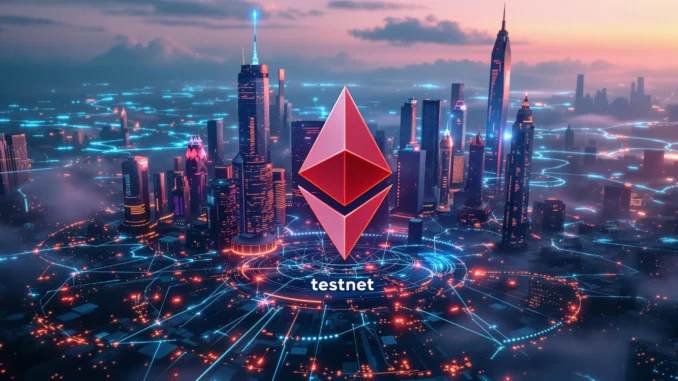
Exciting developments are usually the name of the game in the crypto world, but sometimes, even the most anticipated upgrades hit unexpected roadblocks. That’s precisely what happened with Ethereum’s groundbreaking Pectra upgrade. While the launch on the Holesky testnet was eagerly awaited, it unfortunately stumbled right out of the gate, failing to achieve finality. Let’s dive into what this means for Ethereum and the future of its scalability.
What is the Ethereum Pectra Upgrade and Why is it Important?
The Ethereum Pectra Upgrade is a significant hard fork that bundles together 11 major Ethereum Improvement Proposals (EIPs). Think of it as a comprehensive overhaul designed to enhance various aspects of the Ethereum network. Among these improvements, one stands out for its potential to dramatically increase network efficiency: EIP-7691.
Key highlights of the Pectra Upgrade include:
- EIP-7691: Boosting Data Capacity: This is arguably the star of the show. EIP-7691 aims to significantly increase the blockchain data capacity per block by upping the number of ‘blobs’ Ethereum can handle.
- Enhanced Layer-2 Scalability: By increasing data capacity, Pectra paves the way for layer-2 networks like Polygon, Arbitrum, and Optimism to operate more efficiently and handle even greater transaction volumes on the Ethereum mainnet.
- Future-Proofing Ethereum: Pectra is a crucial step in Ethereum’s ongoing evolution, ensuring it remains competitive and scalable as the demand for decentralized applications and transactions grows.

Holesky Testnet Failure: Unpacking the Finality Issue
The Holesky Testnet Failure occurred shortly after the Pectra upgrade was deployed at 21:55 UTC on February 24th. According to reports, the testnet failed to reach finality. But what exactly does ‘finality’ mean in the context of blockchain, and why is its absence a problem?
Understanding Finality in Blockchain:
- Irreversible Transactions: Finality essentially guarantees that once a transaction is confirmed on the blockchain, it is absolutely, unequivocally irreversible. Think of it as the ‘cement’ that hardens after a transaction is set in stone.
- Security and Trust: Finality is fundamental to the security and trustworthiness of a blockchain. Without it, there’s a risk of transaction reversals or uncertainty, undermining the very principles of decentralization and immutability.
- Ensuring Consensus: Achieving finality means that the network has reached a consensus on the state of the blockchain. All nodes agree on the transaction history, preventing double-spending and other malicious activities.
The exact reasons for the finality failure on the Holesky testnet are still under investigation by Ethereum developers. This highlights the crucial role of testnets – they are designed to uncover potential issues in a controlled environment before upgrades are rolled out to the main Ethereum network.
Why is Finality So Critical for Ethereum’s Operation?
Imagine a financial system where transactions could be reversed after they are considered complete. Chaos, right? That’s precisely why Ethereum Finality Issue is a big deal. Finality is not just a technical term; it’s the bedrock of trust and security in any blockchain network, especially one handling billions of dollars in value.
The Importance of Finality:
- Prevents Double Spending: Finality ensures that once ETH is spent, it’s spent. It cannot be fraudulently reused or double-spent, a critical safeguard against economic attacks.
- Transaction Confidence: Users and businesses rely on finality to have confidence in their transactions. Knowing that a transaction is final allows for secure and predictable operations within the Ethereum ecosystem.
- Foundation for Decentralized Finance (DeFi): DeFi applications, which rely on smart contracts and automated execution, absolutely depend on finality for their logic and security to function as intended.
The lack of finality on the Holesky testnet, therefore, is a serious concern that needs to be addressed before the Pectra upgrade can be confidently deployed on the mainnet.
EIP-7691: Unlocking Enhanced Data Capacity and Layer-2 Scalability
Despite the testnet hiccup, the promise of EIP-7691 remains incredibly exciting. This upgrade is all about boosting blockchain data capacity, which is essential for Ethereum to scale and handle the growing demands of the decentralized web.
How EIP-7691 Enhances Data Capacity:
- Increased Blobs per Block: Currently, Ethereum’s mainnet manages an average of 3 ‘blobs’ (large chunks of data) per block, with a maximum of 6 during peak times. EIP-7691 will double the average to 6 blobs and increase the maximum to 9.
- More Room for Layer-2 Data: This increased capacity provides significantly more space for layer-2 networks to post transaction data and validity proofs onto the Ethereum mainnet.
- Faster and Cheaper Transactions: By making layer-2 networks more efficient, EIP-7691 indirectly contributes to faster and potentially cheaper transactions for users interacting with these scaling solutions.
Imagine layer-2 networks like Polygon or Arbitrum having more ‘bandwidth’ to operate on Ethereum. This translates to a smoother, faster, and more scalable experience for everyone using the Ethereum ecosystem.
Impact of the Testnet Setback and Path to Mainnet Launch
The Holesky Testnet Failure is undoubtedly a setback, but it’s important to remember that testnets are designed to catch these issues. It’s a crucial part of the development process, allowing developers to identify and fix problems before they impact the live mainnet.
Key Takeaways and Next Steps:
- Investigation Underway: Ethereum developers are actively investigating the root cause of the finality failure on Holesky.
- Mainnet Launch Timeline: The Pectra upgrade is still slated for a mainnet launch on April 8th. However, this timeline could be adjusted depending on the findings of the investigation and the time required to implement a fix.
- Importance of Testnets: This incident underscores the vital role of testnets in ensuring the robustness and stability of blockchain upgrades. It’s better to encounter and resolve issues in a test environment than on the live mainnet.
Looking Ahead: The Future of Ethereum’s Pectra Upgrade
While the initial Ethereum Pectra Upgrade launch on Holesky didn’t go as planned, it’s a testament to the rigorous testing and development process within the Ethereum ecosystem. Setbacks are part of innovation, and the Ethereum developer community is known for its resilience and problem-solving capabilities.
The focus now shifts to understanding and resolving the finality issue. Once a solution is identified and implemented, Pectra will likely be redeployed on Holesky for further testing before a mainnet launch. The promise of enhanced data capacity and scalability through EIP-7691 remains a significant step forward for Ethereum. Keep an eye on official Ethereum channels for updates as developers work to get Pectra back on track for a successful mainnet debut.
The journey of blockchain upgrades is rarely without its bumps, but the ultimate destination – a more scalable, efficient, and robust Ethereum – is well worth navigating these challenges. Stay tuned for more updates on the Pectra upgrade as they unfold!



